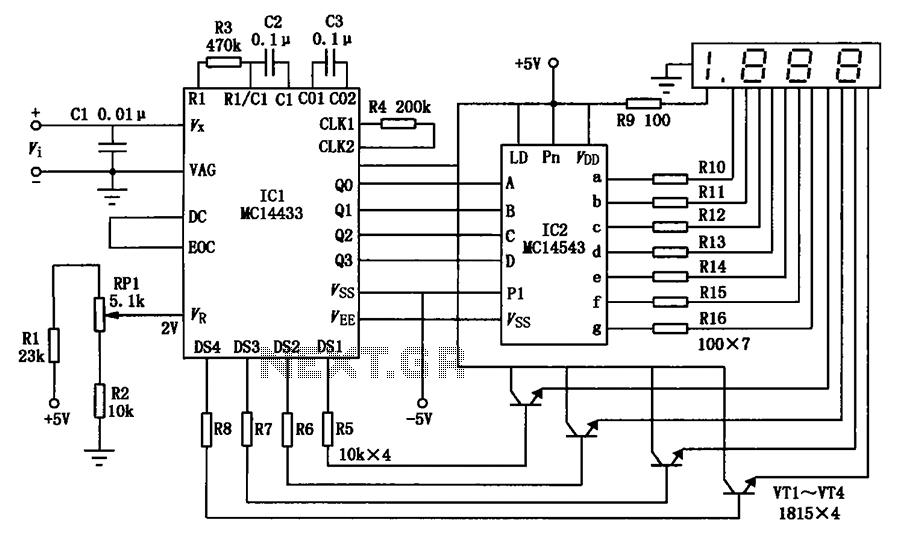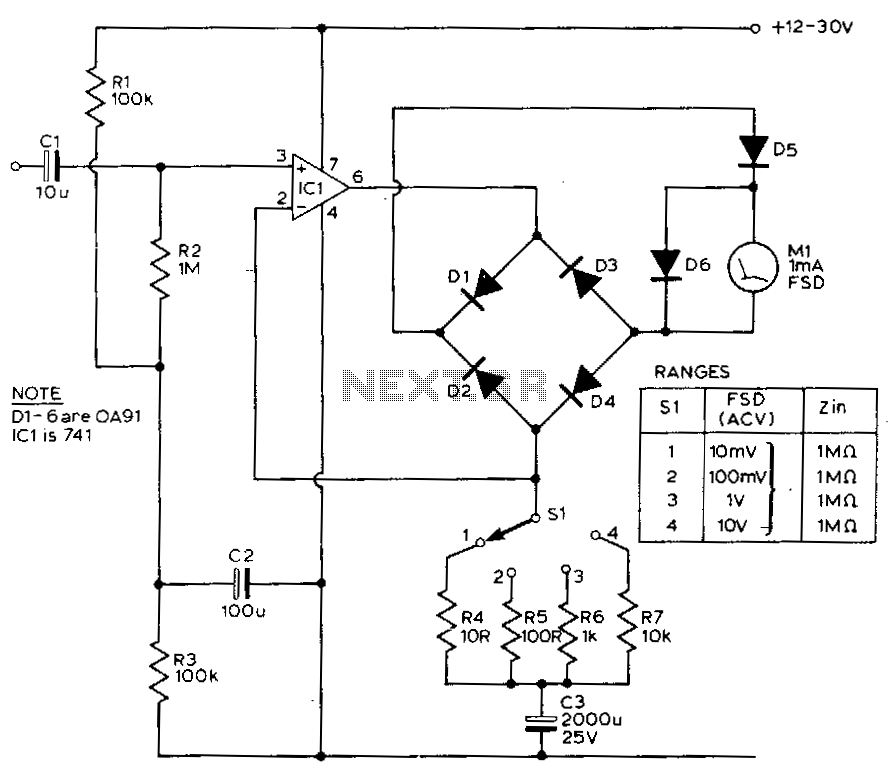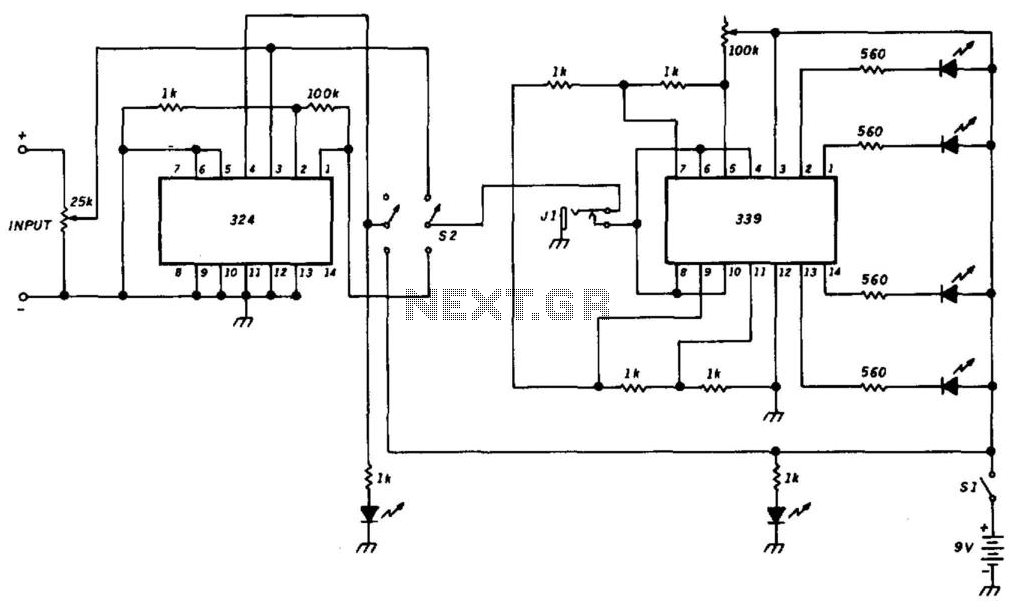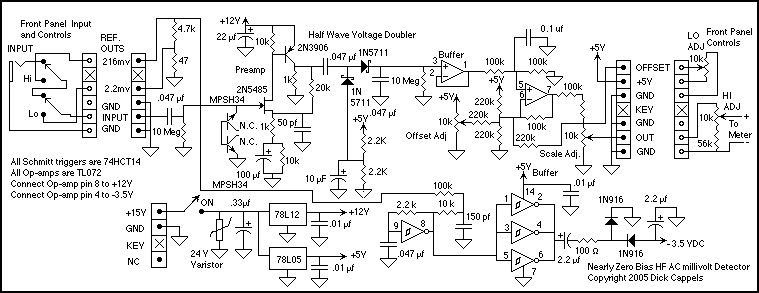
Dc Millivoltmeter
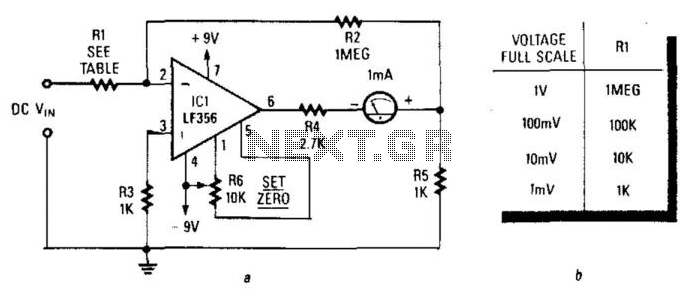
An LF356 operational amplifier is utilized as a gain amplifier, with the output taken across resistor R5. When a full-scale current of 1 mA flows through the meter, a voltage of exactly 1 V appears across R5, which should have a tolerance of 1% or better. This voltage is fed back to resistor R2 at the summing junction of IC1, where a full-scale input is produced. This feedback mechanism offsets the current through resistor R1. Resistor R1 has a value of 1 ohm, which is used to calibrate the meter to zero. Resistor R4 offers overcurrent protection for the meter.
The circuit employs the LF356 operational amplifier, known for its low noise and high-speed characteristics, making it suitable for precision applications. In this configuration, the op-amp is set up in a non-inverting amplifier mode where the gain is determined by the feedback network. The resistor R5 is critical as it serves as a sensing element; the voltage drop across it is directly proportional to the current flowing through it, allowing for accurate current measurement.
The feedback from R5 to R2 ensures that the output voltage of the op-amp is stabilized at 1 V when the full-scale current of 1 mA is applied. This feedback loop helps maintain the desired output level, compensating for any variations in input current. The selection of R2 is vital, as it must be chosen to ensure that the feedback voltage aligns with the operational range of the op-amp, preventing saturation.
Resistor R1, with a value of 1 ohm, functions as a shunt resistor. By providing a known resistance, it enables the calibration of the meter to zero, ensuring that it accurately reflects the current flowing through the circuit. This zeroing process is essential for precise measurements, particularly in applications requiring high accuracy.
R4 is incorporated into the design to protect the meter from potential overcurrent conditions. By limiting the maximum current that can flow through the meter, R4 helps prevent damage to sensitive components, ensuring longevity and reliability in operation. The design of the circuit reflects a careful balance between sensitivity, accuracy, and protection, making it suitable for various measurement applications in electronic systems. An LF356 op amp is used as a gain amplifier with the output taken across R5, When a full-scale current of 1 mA is flowing through the meter, exactly 1 V appears across R5 (should be 1% tolerance or better). This is fed back to R2 to the summing junction of IC1 (a full-scale produces ). This offsets the current through Rl. Rl has a value of 1 /V which is used to zero the meter. R4 provides some overcur-rent protection for the meter.
The circuit employs the LF356 operational amplifier, known for its low noise and high-speed characteristics, making it suitable for precision applications. In this configuration, the op-amp is set up in a non-inverting amplifier mode where the gain is determined by the feedback network. The resistor R5 is critical as it serves as a sensing element; the voltage drop across it is directly proportional to the current flowing through it, allowing for accurate current measurement.
The feedback from R5 to R2 ensures that the output voltage of the op-amp is stabilized at 1 V when the full-scale current of 1 mA is applied. This feedback loop helps maintain the desired output level, compensating for any variations in input current. The selection of R2 is vital, as it must be chosen to ensure that the feedback voltage aligns with the operational range of the op-amp, preventing saturation.
Resistor R1, with a value of 1 ohm, functions as a shunt resistor. By providing a known resistance, it enables the calibration of the meter to zero, ensuring that it accurately reflects the current flowing through the circuit. This zeroing process is essential for precise measurements, particularly in applications requiring high accuracy.
R4 is incorporated into the design to protect the meter from potential overcurrent conditions. By limiting the maximum current that can flow through the meter, R4 helps prevent damage to sensitive components, ensuring longevity and reliability in operation. The design of the circuit reflects a careful balance between sensitivity, accuracy, and protection, making it suitable for various measurement applications in electronic systems. An LF356 op amp is used as a gain amplifier with the output taken across R5, When a full-scale current of 1 mA is flowing through the meter, exactly 1 V appears across R5 (should be 1% tolerance or better). This is fed back to R2 to the summing junction of IC1 (a full-scale produces ). This offsets the current through Rl. Rl has a value of 1 /V which is used to zero the meter. R4 provides some overcur-rent protection for the meter.
